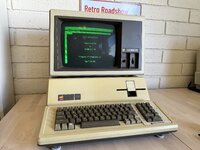Huxley
Well-known member
I'm happy to report that I have gotten one of my two Apple III's running smoothly! With a deep-cleaning, new Reactive Micro "Universal Power Supply," re-soldered Composite video connector, etc., this machine is running nicely. That said, while I'm far from an expert, I'm much more familiar with how Apple II's work, and the AIII is a new experience to me.
So, here's my Big Dumb Beginner-Level Question: I'm grateful that my Apple III's came with a healthy quantity of software on vintage floppies and most of it works, but I can't figure out if the AIII uses a typical "Disk Operating System" or not. All the apps I've used so far are in the form of a bootable disk, but I haven't quite figured out how to just drop into a command line so I can list files or run apps on other disks (like my Floppy Emu). Am I just not understanding how the Apple III works, or do I just need to get an OS disk written?
Thanks for any clarification you guys can offer!
Huxley
PS Here's a pic of my mid-restoration Apple III playing a thrilling game of VisiCalc

So, here's my Big Dumb Beginner-Level Question: I'm grateful that my Apple III's came with a healthy quantity of software on vintage floppies and most of it works, but I can't figure out if the AIII uses a typical "Disk Operating System" or not. All the apps I've used so far are in the form of a bootable disk, but I haven't quite figured out how to just drop into a command line so I can list files or run apps on other disks (like my Floppy Emu). Am I just not understanding how the Apple III works, or do I just need to get an OS disk written?
Thanks for any clarification you guys can offer!
Huxley
PS Here's a pic of my mid-restoration Apple III playing a thrilling game of VisiCalc

